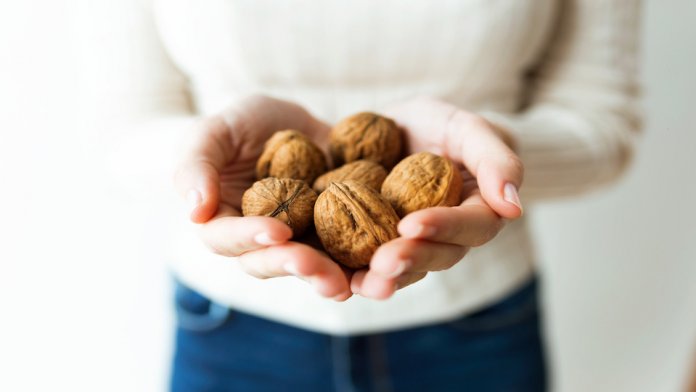In nearly 20 years of clinical practice, I learned a great many lessons from my patients. One of the most valuable is this: Oatmeal means different things to different people. So, when a patient tells me that they eat oatmeal for breakfast…I ask for details. And sometimes I’m shocked. I’ve had patients tell me that they add massive amounts of butter, sugar, cream or even condensed milk which turns their otherwise healthy oatmeal into a decadent dessert rather than a healthy breakfast.
For me, oatmeal is simple…all I add is a bit of frozen fruit, a sprinkle of cinnamon, and a handful of walnuts. And it’s those walnuts that are the subject for today. My team at UpWellness serves up some solid information on how walnuts can benefit your health and how to fit them into your diet in a nutritious and delicious way.
Enjoy,
JL
Inflammation can be your best friend or your worst enemy. In the acute state, inflammation mobilizes special forces within the body that bring healing. In the chronic state, inflammation creeps in and silently and morphs into a lingering state that can last a very long time.
If inflammation remains unchecked, the immune system alerts white blood cells to attack healthy tissues and organs. This is why a chronic inflammatory response plays a major role is some of the most dangerous diseases of today including cancer, diabetes, asthma, heart disease, and Alzheimer’s.
Fighting inflammation with your fork (or spoon)
Lifestyle choices including diet, and even family history all play a role in chronic inflammation. Eating a diet loaded with foods that reduce inflammation can help to keep serious conditions, including those mentioned above, at bay. You might be familiar with foods that help reduce inflammation including the following
- Berries
- Fatty fish
- Peppers
- Mushrooms
- Grapes
- Green tea
- Broccoli
- Avocados
Adding these foods to a healthy diet is one way to stay on top of chronic inflammation.
The one food that you must eat to reduce inflammation
You might be surprised to know that the number one inflammation busting food is walnuts. That’s right; walnuts are loaded with the healthy omega-3 fatty acid known as a-linolenic acid (ALA), powerful nutrients and antioxidants. Of all the nuts, walnuts contain the highest amount of omega-3s and antioxidant polyphenols which give inflammation a powerful one-two punch.
Walnuts are rich in a family of polyphenols called ellagitannins. The most concentrated of these is a compound called pedunculagin which delivers some serious antioxidants and anti-inflammatory benefits. This is why walnuts can protect against heart disease, cancer, and neurodegenerative diseases.
Walnuts are also rich in the fat-soluble vitamin E, that behaves like a powerful antioxidant – protecting against oxidative stress that can cause cancer, arthritis, aging, and other diseases.
In addition to being a great source of antioxidants, walnuts contain a good amount of useful dietary fiber. A 3.5-ounce serving contains over 6 grams of fiber which helps produce gut-supporting metabolites including short-chain fatty acid butyrate.
In one study, researchers assigned almost 200 healthy participants to a diet that was enriched with walnuts (about 2 ounces of walnuts). During the first eight weeks, half of the participants ate walnuts and the other half did not.
During the second eight week period, the researchers reversed the order. The participants who were eating the walnut-enriched diet reduced their intake of fat or carbohydrates or both to balance the additional calories coming from the nuts. The research showed that the consumption of walnuts drastically impacted the gut microbiome and increased the quantity and quality of healthy bacteria.
Additional benefits of eating more walnuts
According to the long-running Nurses’ Health Study, eating walnuts has a number of other significant health benefits including lowering the risk of type 2 diabetes among women (regardless of their body mass index).
In addition, other research shows that eating walnuts can help with weight loss. In one study, overweight or obese participants were divided into three groups. One group added 30 grams of walnuts to their diet daily. At a three month follow up, researchers discovered that the group eating the walnuts had lost a considerable amount of weight and were making healthy food choices.
Additional studies show that consuming walnuts can also improve bad cholesterol and lower blood pressure.
How to get the most out of walnuts
To fight inflammation and reap all of the other benefits walnuts have to offer, enjoy an ounce or two of walnuts daily. Here are some tips for choosing and storing walnuts:
- Choose raw walnuts only – roasted walnuts can contain unhealthy oils
- Walnuts can go rancid quickly so be sure to keep them refrigerated in a tightly sealed container. Pay careful attention to the sell-by date.
- Eat plenty of plant foods including walnuts and also incorporate wild-caught fish into your diet. This helps battle inflammation from a variety of angles.
How to eat more walnuts
Here are some delicious ways to get more walnuts into your diet.
- Top salads
- Grind them into walnut flour
- Top oatmeal
- Process the nuts to make a walnut butter
- Roll goat cheese around the walnuts
- Add walnuts to pancakes
- Throw some into smoothies
- Top a tasty pasta dish
-The UpWellness Team


